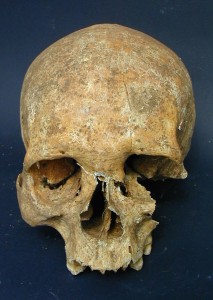Archaeological excavations of the early medieval necropolis in Morrione, in the central Italian region of Molise, have uncovered the bones of a warrior with leprosy. He was approximately 50 years old, and appears to have died from one sword blow to the head. Since lepers were treated like, well, lepers (i.e., societal outcasts separated in life and death from the “clean” population), it’s a surprising discovery to find someone with Hansen’s disease who lived, fought, died and was buried with his comrades.
The skeleton of a female between 40 and 46 years old was also found in the necropolis. There is very little osteological data about leprosy in the archaeological record of Italy. The two skeletons discovered might be able to provide a great deal of new information about the pathological and sociological history of the disease in Italy.
The cemetery was in use between the sixth and eighth centuries. There was no permanent settlement at that time, so the burial ground had to have been used by the Lombards, a Germanic people who invaded Italy in 568 along with their allies the Avars, a Eurasian confederation of nomadic warriors, who had a military outpost in the area.
[The warrior's] bones show the telltale wasting and mutilation of leprosy, now known as Hansen’s disease. In ancient times, leprosy sufferers were often banished from society. Apparently the Lombards and Avars took a more tolerant approach, Rubini said, because this man, who died around age 50, was buried in the cemetery along with the other dead. [...]
“The Avar society was very inflexible militarily, and in particular situations all are called to contribute to the cause of survival, healthy and sick,” [Foggia University anthropologist Mauro Rubini] said. “Probably this individual was really a leper warrior who died in combat to defend his people against the Byzantinian soldiers.”
Horse and rider buried togetherSo far 234 graves have been excavated. We can learn a great deal more we don’t know about Lombard and Avar cultures from their buried dead. There is evidence of successful battlefield surgery, for example. One skull has a 2-inch hole in it, probably made by a Byzantine mace, whose edges were cleaned and abraded until smooth. Regrowth of bone indicates that the surgery was successful. Another skull with a wedge-shaped dent, possibly made by a Byzantine battle-axe, also shows signs that the recipient of the blow survived it and lived for some time after.
Many of the warriors were found buried with their horses, a common practice among nomadic Asian peoples that must have continued to be practiced by the Avars in Italy.
For more interesting topics related to archaeology, visit archaeology excavations.
Archaeology excavation is best known and most commonly used within the science of archaeology. In this sense it is the exposure, processing and recording of archaeological remains.
Friday, April 29, 2011
Bones of leper warrior found in Lombard cemetery
Subscribe to:
Post Comments (Atom)

No comments:
Post a Comment